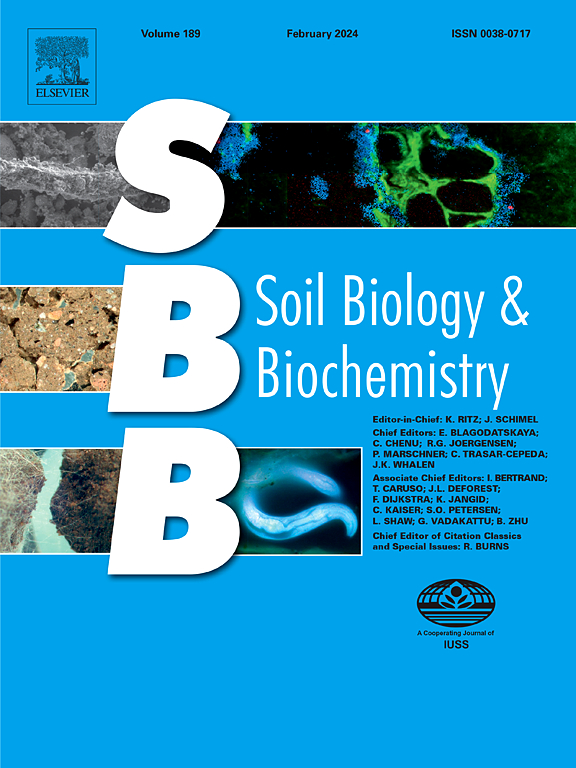Energy and matter dynamics in an estuarine soil are more sensitive to warming than salinization
IF 9.8
1区 农林科学
Q1 SOIL SCIENCE
引用次数: 0
Abstract
Rising salinization of extended river-sides and estuary areas due to climate warming might alter microbial metabolic activity and cause unpredictable consequences for matter and energy turnover in soil. Therefore, we investigated the combined effects of salinization and warming on microbial activity and growth, examining CO₂ emissions (matter loss) and heat production (energy loss) during glucose metabolism. Soil from Elbe estuary was artificially salinized to medium (2.06 mS cm−1) and high (3.45 mS cm−1) levels, and ambient low salinity soil (0.93 mS cm−1) served as the control. We examined the influence of a comprehensive +2 °C climate warming (20 vs. 22 °C) on soil respiration (CO2 emission), heat release, enzyme kinetics (cellobiohydrolase, β-glucosidase, acid phosphomonoesterase and leucine-aminopeptidase) and microbial carbon use efficiency (CUE) across the microbial growth.
Increasing salinity did not impact respiration, heat release, microbial C and N content without glucose addition. However, activation of microorganisms with glucose brought force to the effect of salinity, and increasing salinity consistently retarded substrate uptake and growth. 2 °C warming affected substrate uptake and growth much more than increasing salinity. The calorespirometric ratio increased by 81–124% under high salinity compared to low salinity, with most of this increase occurring during the growth retardation stage. Enzyme activities increased by 68%–871% during the lag phase and remained relatively high throughout both the growth and retardation stages, regardless of salinity and temperature levels, suggesting the resistance of soil hydrolytic enzymes. The CUE gradually decreased and stabilized only at the very end of microbial growth, emphasizing the importance of considering the growth retardation for CUE estimation. Remarkably, disregarding the growth retardation stage resulted in a strong overestimation of the CUE accounting for 70%–98%. Our results highlight the importance of estimating the carbon budget of microbial growth by considering its dynamics when modeling carbon sequestration under global climate change.
河口土壤的能量和物质动态对变暖比盐渍化更敏感
由于气候变暖,延伸的河岸和河口地区的盐碱化可能会改变微生物的代谢活动,并对土壤中的物质和能量转换造成不可预测的后果。因此,我们研究了盐碱化和升温对微生物活动和生长的综合影响,考察了葡萄糖代谢过程中的CO₂排放(物质损失)和热量产生(能量损失)。将易北河口土壤人工盐渍化至中(2.06 mS cm-1)和高(3.45 mS cm-1)水平,并以环境低盐度土壤(0.93 mS cm-1)为对照。我们研究了+2°C全面气候变暖(20°C vs. 22°C)对土壤呼吸(CO2排放)、热量释放、酶动力学(纤维素生物水解酶、β-葡萄糖苷酶、酸性磷酸单酯酶和亮氨酸-氨基肽酶)和微生物碳利用效率(CUE)在微生物生长过程中的影响。在不添加葡萄糖的情况下,增加盐度对呼吸、放热、微生物C和N含量没有影响。然而,葡萄糖对微生物的激活会使盐度的作用变得更强,盐度的增加会持续延缓底物的吸收和生长。2°C变暖对基质吸收和生长的影响远大于盐度的增加。与低盐度相比,高盐度下的热肺比增加了81 ~ 124%,其中大部分增加发生在生长迟缓期。酶活性在迟滞期增加68% ~ 871%,在生长和迟滞期均保持较高水平,与盐度和温度水平无关,表明土壤水解酶具有抗性。只有在微生物生长的最后阶段,CUE才逐渐下降并趋于稳定,这强调了在估计CUE时考虑生长迟缓的重要性。值得注意的是,忽略生长迟滞期导致对CUE的强烈高估,占70%-98%。我们的研究结果强调了在模拟全球气候变化下的碳封存时,考虑微生物生长的动态来估计其碳收支的重要性。
本文章由计算机程序翻译,如有差异,请以英文原文为准。
求助全文
约1分钟内获得全文
求助全文
来源期刊

Soil Biology & Biochemistry
农林科学-土壤科学
CiteScore
16.90
自引率
9.30%
发文量
312
审稿时长
49 days
期刊介绍:
Soil Biology & Biochemistry publishes original research articles of international significance focusing on biological processes in soil and their applications to soil and environmental quality. Major topics include the ecology and biochemical processes of soil organisms, their effects on the environment, and interactions with plants. The journal also welcomes state-of-the-art reviews and discussions on contemporary research in soil biology and biochemistry.
 求助内容:
求助内容: 应助结果提醒方式:
应助结果提醒方式:


